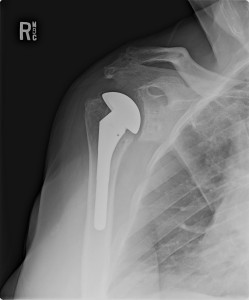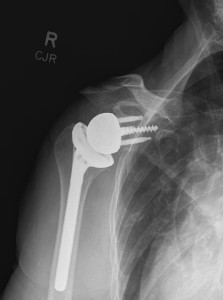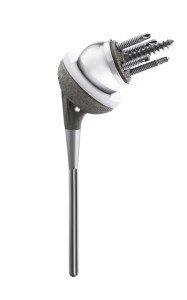Shoulder Replacement, or Total Shoulder Arthroplasty, is a surgery for some patients with shoulder arthritis.
This is a very effective surgery for pain relief. In simple terms, the painful joint surfaces are removed and replace with new parts to recreate a new ball-and-socket joint. Depending on the status of the muscles that surround the shoulder, there are two ways to replace the shoulder.
Standard Shoulder Replacement
The first type of shoulder replacement is the standard, or anatomic total shoulder arthroplasty. This recreates a new ball-and-socket joint. The humeral head (the ball) is replaced with a new, smooth metal alloy ball. This is attached to a stem that holds it in place. The socket is then smoothed down, and replaced with a special plastic socket. This is the new ball and socket joint. The x-ray below shows a standard shoulder replacement. The new socket is a special plastic that you can’t see on x-ray.
Reverse Shoulder Replacement
The second type of Shoulder Replacement is a Reverse Total Shoulder Arthroplasty. This type is usually used in patients with large tears in their rotator cuff. This type also replaces the ball-and-socket joint, but as the name implies, reverses the ball-and-socket. So there is now a ball where there was previously a socket, and the old ball is now the socket. The reason this is done is to change the rotation point of the shoulder. With a new point to rotate around, the deltoid muscle can now perform the activities of the non-functioning rotator cuff. This can significantly improve the function of the shoulder. The x-ray and figure below show what a reverse shoulder replacement looks like.
Shoulder Replacement Surgery
Shoulder replacement is done in a hospital operating room and usually involves a two-night stay in the hospital. This is to make sure you have recovered from the surgery and anesthesia without any problems, and that your pain is controlled on pain pills.
Shoulder Replacement Recovery
Initially after surgery the arm is kept in an immobilizer. This is discontinued a few weeks after surgery as we start working on motion. Most patients have significantly less pain at their 2 week post-op visit than they did prior to surgery. While full recovery can take 6-12 months, most patients have better function than prior to surgery within 2-3 months. Our team will guide you through that process to maximize your recovery.
Shoulder replacements can now be performed as a same-day outpatient procedure. Click here to learn more.



